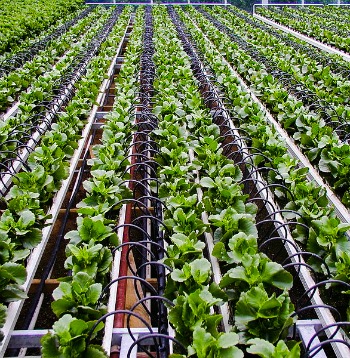The world’s population continues to rise through the years but our resources are dwindling and other environmental factors make traditional farming more challenging. Water is always a constant threat whether in excess or the lack of it. Floods ravage farming communities while droughts make it impossible for crops to grow.
 Climate change is another threat that for sure will only get worse as the years go by. Add to that the fact that a big chunk of agricultural lands is being converted into suburban communities, industries, or commercial complexes. Indeed, the agricultural sector is suffering. What many of us fail to realize now is that it is us who will eventually suffer once food becomes scarce and not enough to meet our growing needs.
Climate change is another threat that for sure will only get worse as the years go by. Add to that the fact that a big chunk of agricultural lands is being converted into suburban communities, industries, or commercial complexes. Indeed, the agricultural sector is suffering. What many of us fail to realize now is that it is us who will eventually suffer once food becomes scarce and not enough to meet our growing needs.
There are times that Mother Nature is just too darn unpredictable.
When everything goes without a hitch, the U.S. typically has an abundant supply of vegetables. But throw in rainy weather, delays that move back planting and harvesting, and all of a sudden you have a case of panicky buyers who are keen to look for more predictable and nearby sources of supply.
Retailers and consumers in the United Kingdom in February suffered a shock when rains in Spain caused some stores to ration their supply of greens. Some California companies saw an opportunity and shipped lettuce to the U.K.
Now it’s California facing rain-related production problems. The Packer has covered the gaps in vegetable supply in California, and various marketers predict it will get worse before it gets better. The rains that brought relief to the Golden State could give buyers a roller coaster ride later this spring.
(Via: http://www.thepacker.com/news/opinion/mother-nature-gives-indoor-farms-boost)
There is nothing much we can do once calamity strikes. It will not only take lives, destroy properties and displace people but also affect the food supply and demand. What can we do to cope then?
A new farming company is growing its produce at a quicker and more cost-effective rate than traditional farms.
The secret to the success? The produce is grown indoors.
Bowery, based in the southern section of Kearny, was founded two years ago by Irving Fain and officially launched last week. The company dubs itself as the first to grow “post organic produce.”
“We have completely pure and clean crops,” Fain said.
By growing produce – like kale and arugula – indoors, Fain said the company eliminates dealing with harsh weather conditions and is able to bring its products to local retailers quicker then other distributors.
Now, you are probably wondering how do they do it?
Using hydroponic techniques and software that controls the atmosphere inside the farm, produce crews significantly quicker without using any pesticides.
(Via: http://www.nj.com/hudson/index.ssf/2017/03/indoor_farming_company_launches_in_kearny.html)
And the experts can’t help but agree.
If agriculture is to continue to feed the world, it needs to become more like manufacturing, says Geoffrey Carr. Fortunately, that is already beginning to happen.
Technology, however, has come to Mr. Rogers’s aid. His farm is wired up like a lab rat. Or, to be more accurate, it is wirelessed up. Moisture sensors planted throughout the nut groves keep track of what is going on in the soil. They send their results to a computer in the cloud (the network of servers that does an increasing amount of the world’s heavy-duty computing) to be crunched. The results are passed back to the farm’s irrigation system—a grid of drip tapes (hoses with holes punched in them) that are filled by pumps.
The system resembles the hydroponics used to grow vegetables in greenhouses. Every half-hour a carefully calibrated pulse of water based on the cloud’s calculations, and mixed with an appropriate dose of fertiliser if scheduled, is pushed through the tapes, delivering a precise sprinkling to each tree. The pulses alternate between one side of the tree trunk and the other, which experience has shown encourages water uptake. Before this system was in place, Mr Rogers would have irrigated his farm about once a week. With the new little-but-often technique, he uses 20% less water than he used to. That both saves money and brings kudos, for California has suffered a four-year-long drought and there is social and political, as well as financial, pressure to conserve water.
Mr. Rogers’s farm, and similar ones that grow other high-value but thirsty crops like pistachios, walnuts and grapes, are at the leading edge of this type of precision agriculture, known as “smart farming”. But it is not only fruit and nut farmers who benefit from being precise. So-called row crops—the maize and soyabeans that cover much of America’s Midwest—are being teched up, too. Sowing, watering, fertilising and harvesting are all computer-controlled. Even the soil they grow in is monitored to within an inch of its life.
(Via: http://www.economist.com/technology-quarterly/2016-06-09/factory-fresh)
Smart farming is now possible and farmers should look into this option in growing their crops. It may sound daunting for many but it actually proved to be a success in different farms all over America. With a little help from government agencies and private organizations that provide funding, indoor farming may be the solution we are all looking for to solve our intermittent food crisis.
Crops are no longer vulnerable to the elements and there is a promise of its steady food supply all year round regardless of environmental changes or seasonal weather variations.
